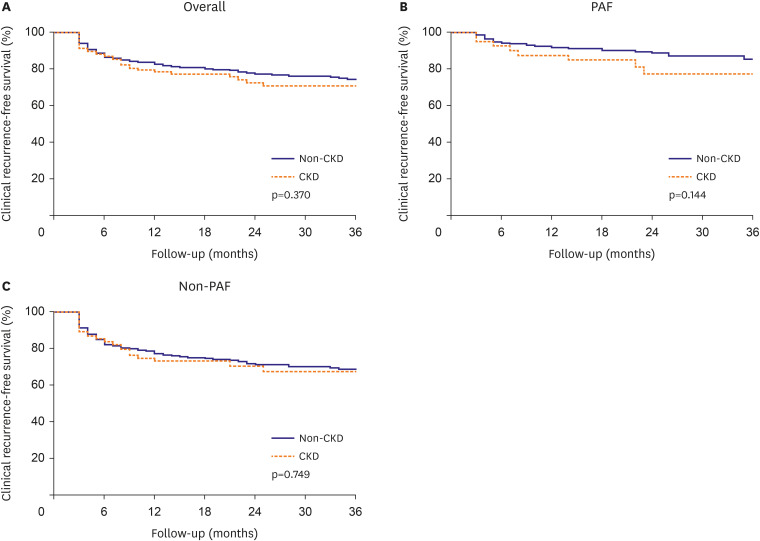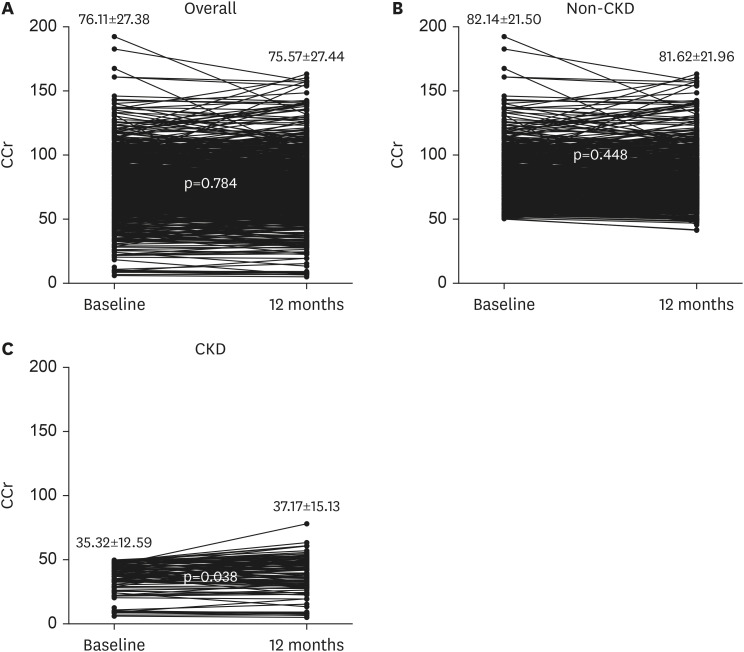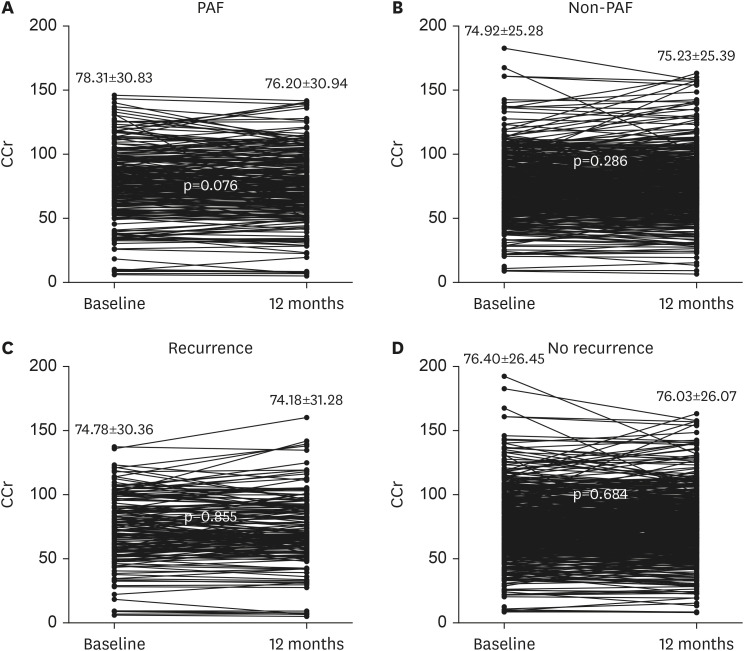Korean Circ J.
2024 Mar;54(3):113-123. 10.4070/kcj.2023.0194.
Clinical Outcomes of Intracardiac Echocardiography-Guided Contrast Agent-Free Cryoballoon Ablation in Atrial Fibrillation Patients With Renal Insufficiency
- Affiliations
-
- 1Division of Cardiology, Hallym University Kangnam Sacred Heart Hospital, Seoul, Korea
- 2Division of Cardiology, Department of Internal Medicine, Pusan National University Hospital, Busan, Korea
- 3Department of Internal Medicine, Daejeon Eulji Medical Center, Eulji University School of Medicine, Daejeon, Korea
- 4Division of Cardiology, Hallym University Sacred Heart Hospital, Hallym University College of Medicine, Anyang, Korea
- KMID: 2554138
- DOI: http://doi.org/10.4070/kcj.2023.0194
Abstract
- Background and Objectives
Previous studies have reported an association between impaired renal function and poor outcomes after radiofrequency catheter ablation in patients with atrial fibrillation (AF). However, outcomes of cryoballoon ablation (CBA) in patients with renal insufficiency are not fully elucidated. This study aimed to compare outcomes of CBA in AF patients with chronic kidney disease (CKD) versus those without CKD and to assess changes in renal function over 12 months following CBA.
Methods
A total of 839 patients (65.1% with non-paroxysmal AF [PAF]) who underwent de novo CBA were prospectively enrolled. We divided patients into two groups based on creatinine clearance rate (CCr) and performed intracardiac echocardiography (ICE)-guided contrast agent-free CBA.
Results
In comparison with patients without CKD (CCr >50, n=722), those with CKD (CCr ≤50, n=117) were older and predominantly female, had a lower body mass index, and showed a higher prevalence of heart failure and hypertension. Mean CHA 2 DS 2 -VAS score was significantly higher in CKD group than in non-CKD group. Procedure-related complications were not significantly different between two groups. During a mean follow-up period of 25.4±11.9 months, clinical recurrence occurred in 182 patients (21.7%) and not significantly different between two groups. In multivariate analysis, non-PAF and left atrial size were independent predictors of AF recurrence. CCr levels significantly improved over 12 months after CBA in CKD group.
Conclusions
ICE-guided contrast-agent-free CBA showed comparable long-term clinical outcomes without increasing procedure-related complications and improvement of renal function over 12 months following CBA in AF patients with CKD.
Figure
Reference
-
1. Kirchhof P, Benussi S, Kotecha D, et al. 2016 ESC Guidelines for the management of atrial fibrillation developed in collaboration with EACTS. Eur Heart J. 2016; 37:2893–2962. PMID: 27567408.2. Soliman EZ, Prineas RJ, Go AS, et al. Chronic kidney disease and prevalent atrial fibrillation: the Chronic Renal Insufficiency Cohort (CRIC). Am Heart J. 2010; 159:1102–1107. PMID: 20569726.3. Boriani G, Savelieva I, Dan GA, et al. Chronic kidney disease in patients with cardiac rhythm disturbances or implantable electrical devices: clinical significance and implications for decision making-a position paper of the European Heart Rhythm Association endorsed by the Heart Rhythm Society and the Asia Pacific Heart Rhythm Society. Europace. 2015; 17:1169–1196. PMID: 26108808.4. Haïssaguerre M, Jaïs P, Shah DC, et al. Spontaneous initiation of atrial fibrillation by ectopic beats originating in the pulmonary veins. N Engl J Med. 1998; 339:659–666. PMID: 9725923.5. Khan AR, Khan S, Sheikh MA, Khuder S, Grubb B, Moukarbel GV. Catheter ablation and antiarrhythmic drug therapy as first- or second-line therapy in the management of atrial fibrillation: systematic review and meta-analysis. Circ Arrhythm Electrophysiol. 2014; 7:853–860. PMID: 25110162.6. Ullal AJ, Kaiser DW, Fan J, et al. Safety and clinical outcomes of catheter ablation of atrial fibrillation in patients with chronic kidney disease. J Cardiovasc Electrophysiol. 2017; 28:39–48. PMID: 27782345.7. Sairaku A, Yoshida Y, Kamiya H, et al. Outcomes of ablation of paroxysmal atrial fibrillation in patients on chronic hemodialysis. J Cardiovasc Electrophysiol. 2012; 23:1289–1294. PMID: 22913591.8. Takahashi Y, Takahashi A, Kuwahara T, et al. Renal function after catheter ablation of atrial fibrillation. Circulation. 2011; 124:2380–2387. PMID: 22042886.9. Navaravong L, Barakat M, Burgon N, et al. Improvement in estimated glomerular filtration rate in patients with chronic kidney disease undergoing catheter ablation for atrial fibrillation. J Cardiovasc Electrophysiol. 2015; 26:21–27. PMID: 25142836.10. Li M, Liu T, Luo D, Li G. Systematic review and meta-analysis of chronic kidney disease as predictor of atrial fibrillation recurrence following catheter ablation. Cardiol J. 2014; 21:89–95. PMID: 23990188.11. Lee WC, Wu PJ, Fang CY, Chen HC, Chen MC. Impact of chronic kidney disease on atrial fibrillation recurrence following radiofrequency and cryoballoon ablation: a meta-analysis. Int J Clin Pract. 2021; 75:e14173. PMID: 33756030.12. Chung I, Khan Y, Warrens H, Seshasai RK, Sohal M, Banerjee D. Catheter ablation for atrial fibrillation in patients with chronic kidney disease and on dialysis: a meta-analysis and review. Cardiorenal Med. 2022; 12:155–172. PMID: 35820393.13. Kuck KH, Brugada J, Fürnkranz A, et al. Cryoballoon or radiofrequency ablation for paroxysmal atrial fibrillation. N Engl J Med. 2016; 374:2235–2245. PMID: 27042964.14. Yanagisawa S, Inden Y, Kato H, et al. Impaired renal function is associated with recurrence after cryoballoon catheter ablation for paroxysmal atrial fibrillation: a potential effect of non-pulmonary vein foci. J Cardiol. 2017; 69:3–10. PMID: 27499270.15. Boriani G, Iacopino S, Arena G, et al. Chronic kidney disease with mild and mild to moderate reduction in renal function and long-term recurrences of atrial fibrillation after pulmonary vein cryoballoon ablation. J Cardiovasc Dev Dis. 2022; 9:126. PMID: 35621837.16. Diaz CL, Kaplan RM, Peigh G, et al. Improvement in renal function following cryoballoon ablation for atrial fibrillation. J Interv Card Electrophysiol. 2021; 60:513–520. PMID: 32415554.17. Ahn J, Shin DG, Han SJ, Lim HE. Does isolation of the left atrial posterior wall using cryoballoon ablation improve clinical outcomes in patients with persistent atrial fibrillation? A prospective randomized controlled trial. Europace. 2022; 24:1093–1101. PMID: 35138376.18. Ahn J, Shin DG, Han SJ, Lim HE. Safety and efficacy of intracardiac echocardiography-guided zero-fluoroscopic cryoballoon ablation for atrial fibrillation: a prospective randomized controlled trial. Europace. 2023; 25:euad086. PMID: 37021403.19. Garvanski I, Simova I, Angelkov L, Matveev M. Predictors of recurrence of AF in patients after radiofrequency ablation. Eur Cardiol. 2019; 14:165–168. PMID: 31933685.20. Njoku A, Kannabhiran M, Arora R, et al. Left atrial volume predicts atrial fibrillation recurrence after radiofrequency ablation: a meta-analysis. Europace. 2018; 20:33–42. PMID: 28444307.21. Kornej J, Hindricks G, Shoemaker MB, et al. The APPLE score: a novel and simple score for the prediction of rhythm outcomes after catheter ablation of atrial fibrillation. Clin Res Cardiol. 2015; 104:871–876. PMID: 25876528.22. Mesquita J, Ferreira AM, Cavaco D, et al. Development and validation of a risk score for predicting atrial fibrillation recurrence after a first catheter ablation procedure - ATLAS score. Europace. 2018; 20:f428–f435. PMID: 29016770.23. Canpolat U, Aytemir K, Yorgun H, Şahiner L, Kaya EB, Oto A. A proposal for a new scoring system in the prediction of catheter ablation outcomes: promising results from the Turkish Cryoablation Registry. Int J Cardiol. 2013; 169:201–206. PMID: 24063932.24. Winkle RA, Jarman JW, Mead RH, et al. Predicting atrial fibrillation ablation outcome: the CAAP-AF score. Heart Rhythm. 2016; 13:2119–2125. PMID: 27435586.25. Bisbal F, Alarcón F, Ferrero-de-Loma-Osorio A, et al. Left atrial geometry and outcome of atrial fibrillation ablation: results from the multicentre LAGO-AF study. Eur Heart J Cardiovasc Imaging. 2018; 19:1002–1009. PMID: 29659784.26. Mujović N, Marinković M, Marković N, Shantsila A, Lip GY, Potpara TS. Prediction of very late arrhythmia recurrence after radiofrequency catheter ablation of atrial fibrillation: the MB-LATER clinical score. Sci Rep. 2017; 7:40828. PMID: 28106147.27. Bordignon S, Chen S, Bologna F, et al. Optimizing cryoballoon pulmonary vein isolation: lessons from >1000 procedures- the Frankfurt approach. Europace. 2021; 23:868–877. PMID: 33458770.28. Suwanwongse K, Shabarek N. Does atrial fibrillation increase the risk of developing end-stage renal disease in patients with chronic kidney disease? Cureus. 2020; 12:e6908. PMID: 32190463.29. Iravanian S, Dudley SC Jr. The renin-angiotensin-aldosterone system (RAAS) and cardiac arrhythmias. Heart Rhythm. 2008; 5:S12–S17. PMID: 18456194.30. Li J, Solus J, Chen Q, et al. Role of inflammation and oxidative stress in atrial fibrillation. Heart Rhythm. 2010; 7:438–444. PMID: 20153266.
- Full Text Links
- Actions
-
Cited
- CITED
-
- Close
- Share
- Similar articles
-
- Cryoballoon Ablation for Atrial Fibrillation: a Comprehensive Review and Practice Guide
- Cryoballoon or Radiofrequency Ablation for Paroxysmal Atrial Fibrillation
- Is ICE-Guided Cryoballoon Ablation for Atrial Fibrillation a New Advancement?
- Pulmonary veins isolation using cryoballoon and pulsed field ablation for atrial fibrillation: practical techniques in variable scenarios
- Large Circular Ring Catheter Ablation Versus Anatomically Guided Ablation of Atrial Fibrillation: Back to the Future for Successful Catheter Ablation of Atrial Fibrillation?




